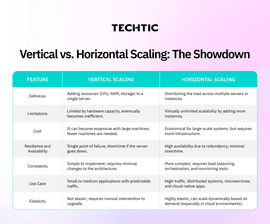Scaling Node.js Applications: Horizontal vs Vertical Scaling
Sector: Technology
Author: Nisarg Mehta
Date Published: 06/17/2025

Contents
Okay, so it’s 2025. And if you’re building software, you’ve probably already felt it: the sheer, unrelenting pressure for scalable applications. Businesses globally are literally bending over backward trying to keep up with user demand.
Here’s the deal: scalability – that’s your app handling more users without falling on its face, basically – isn’t some fancy extra anymore. It’s the absolute baseline, the non-negotiable entry ticket to staying relevant. And frankly, for me, Node.js, with its unique non-blocking, event-driven architecture, has become the go-to champion for building these kinds of resilient, scale-ready systems.
But here’s the kicker, and trust me, every developer wrestles with this: once your Node.js app starts seeing real traction, that seemingly simple question hits you: “How do we actually scale this thing?”
You’re almost immediately looking at two big players: horizontal scaling (that’s scaling out) and vertical scaling (which is scaling up). Both have their moments, their quirks, and their ideal scenarios. Deciding between them? That’s half the battle right there.
So, enough preamble. Let’s rip into the comparison.
Node.js Scalability: Understanding the Beast
Before we dive into the nuts and bolts of how to scale, let’s get on the same page about what scalability even means in today’s rapid-fire application landscape. It’s not just a buzzword, believe me.
Scalability: Not Just a Buzzword, a Lifeline
Scalability, at its core, is about your application’s capacity to handle a growing workload. Or, to put it simply, its ability to expand when things get busy. Think about it: as your user base explodes, data piles up, or workflows shift, your app simply must keep purring along, maintaining snappy response times and minimizing dreaded downtime.
For Node.js apps, this is paramount. Yes, its single-threaded, non-blocking I/O model is brilliant for juggling tons of concurrent requests efficiently. But here’s the curveball, and this is where I’ve seen countless teams stumble: when that traffic really starts to ramp up, you’re forced to pick: do we pile more resources onto one machine (vertical scaling)? Or do we spread the load across many (horizontal scaling)? It’s a fork in the road moment.
Vertical vs. Horizontal Scaling: The Showdown
Let’s get real about these two scaling philosophies:

Vertical Scaling (Scaling Up): The "Bigger Engine" Approach
Vertical scaling is pretty straightforward: you just throw more power at your existing server – more CPU, more RAM, more storage. It’s about upgrading that single machine to handle heavier traffic. For your Node.js setup, this often means moving your app from, say, a tiny cloud VM to a much beefier one. Honestly, it’s tempting for its simplicity. You’re giving one hard worker a huge pay raise and a better desk.
Horizontal Scaling (Scaling Out): The "More Workers" Approach
Horizontal scaling, on the other hand, is a different beast entirely. Here, you’re not upgrading one machine; you’re adding more. Think multiple copies of your application running across different servers, with load balancers elegantly directing traffic to keep things smooth. This is where you start building a truly distributed system. This feels more complicated initially, but it’s how the big leagues play. You’re not just making one employee super productive; you’re hiring an entire team.
In a nutshell, vertical scaling beefs up one machine, while horizontal scaling distributes the work across many. Picking the right path? That’s where the art of system design truly begins.
Let’s dive a bit deeper into each type of scaling.
Vertical Scaling in Node.js
Vertical scaling, or what most folks call “scaling up,” is a super straightforward approach. You just pump up the resources (think more CPU, RAM, or storage) of a single server to handle a heavier load. For Node.js applications, this can often feel like the easiest, quickest fix, especially when you’re starting out with limited infrastructure and don’t want to overcomplicate things.
How Vertical Scaling Works (It's Pretty Simple, Really)
In the context of your Node.js setup, vertical scaling literally means upgrading the existing hardware. So, for instance, you might move your Node.js app from a server rocking 4 GB of RAM to one that’s got 16 GB. Or, you could switch to a server packing more powerful CPUs. The core idea? By boosting the sheer muscle of a single server, you can chew through more requests, handle more processes, or serve more users without needing to tweak your core application architecture at all. No messy code changes required, which is a big win for many.
Pros of Vertical Scaling
- Simple Implementation: A Developer’s Dream (Sometimes): The absolute biggest upside of vertical scaling is its sheer simplicity. You don’t need to get into a whole architectural overhaul or wrestle with complex load balancers. Just upgrade your hardware, and boom, your server’s ready for more traffic.
- Cost-Effective for Small to Medium Applications: Initial Savings: If your application is still relatively small, or perhaps just getting off the ground, vertical scaling can be a surprisingly cost-effective way to manage early growth. No major redesign headaches, no huge upfront investments in distributed systems.
- Easier Management: Fewer Headaches: Let’s be honest, managing one beefed-up server is almost always less of a headache than trying to wrangle a whole cluster of machines. Fewer moving parts generally means less complexity when you’re trying to keep the infrastructure humming.
Cons of Vertical Scaling
- Limited by Hardware: The Glass Ceiling: Here’s the really big problem with vertical scaling: you’re ultimately hitting a physical ceiling. Servers can only be supercharged so much. At some point, just stuffing in more CPU or RAM simply won’t cut it for that ever-increasing load. Eventually, you’ll reach a point where further upgrades are impossible, or the cost of those upgrades becomes absolutely ridiculous.
- Single Point of Failure: A House of Cards: When your entire operation hinges on one server, that server instantly becomes a single point of failure. If that machine coughs, sputters, or goes down completely, guess what? Your entire application vanishes from the internet. Hello, significant downtime and very unhappy users.
- Cost Inefficiency at Scale: Beware the Premium: While it might save you cash for smaller apps, vertical scaling actually becomes wildly inefficient as you grow. Those massive machines with top-tier RAM, CPU, and storage? They come with eye-watering price tags. Plus, you’ve got to make sure your application can even use all those extra resources effectively. Otherwise, you’re just lighting money on fire for unused capacity. Nobody wants that.
Best Use Cases for Vertical Scaling
Vertical scaling is often the smart first move if:
- Your application is genuinely small to medium-sized and has traffic that you can pretty much predict.
- You’re stuck with a monolithic architecture, and trying to refactor it for horizontal scaling would be a total nightmare right now.
- You just need a quick, simple solution to handle moderate growth without diving into the deep end of managing multiple instances.
For many startups or smaller applications, vertical scaling is a no-brainer for quick, cost-effective scaling. However, and this is a crucial “but,” as the application really takes off or traffic becomes wildly unpredictable, you’ll definitely need to start looking seriously at horizontal scaling options. It’s almost inevitable.
Horizontal Scaling in Node.js
Horizontal scaling – or as I like to call it, “scaling out” – is hands-down the more flexible and robust way to pump up an application’s capacity. Instead of just beefing up one monster server (like we talked about with vertical scaling), we’re adding more machines, more instances. This approach fundamentally changes the game by spreading the load across a bunch of servers or containers, which ultimately buys you loads more fault tolerance, redundancy, and, well, outright scalability.
How Horizontal Scaling Works (Think Teamwork, Not Solo Heroics)
When it comes to Node.js, horizontal scaling generally means you’re deploying multiple copies – or “instances” – of your application. These can be on different physical servers, virtual machines, or inside containers. The magic? They all work together, handling requests in parallel. And to make sure no single instance gets overwhelmed, you absolutely need a load balancer. Tools like Nginx, HAProxy, or even cloud-native solutions like AWS Elastic Load Balancer step in to ensure traffic gets distributed nice and evenly across all those active instances.
Key Components of Horizontal Scaling: (Because It's Not Just About Adding Servers)
- Clustering: The Local Scaling Hack: Node.js actually has a built-in cluster module. You can use it to spawn multiple instances of your app, which is awesome for really squeezing all the juice out of multi-core systems. Here’s the catch though: while it helps your Node.js app utilize all cores on a single machine, it’s still ultimately tied to one server. It’s a fantastic local optimization, but it doesn’t quite unleash the true potential of distributed horizontal scaling.
- Containers and Orchestration: The Modern Way to Play: This is where things get really interesting, and frankly, essential for large-scale operations. We’re talking about taking your Node.js application, shoving it into a container (hello, Docker!), and then letting an orchestration engine like Kubernetes or Docker Swarm manage these containers across multiple machines or cloud instances. The beauty of this? It’s largely automatic. Kubernetes even has Horizontal Pod Autoscaling (HPA), which will dynamically crank up or dial down the number of running instances based on real-time demand. It’s like having an intelligent operations team working 24/7.
- Load Balancing: The Traffic Cop: Make no mistake, a load balancer isn’t just “a component”; it’s the central nervous system of horizontal scaling. Its job? To ensure incoming traffic gets distributed fairly among all the available instances, preventing any single server from turning into a bottleneck. Even better, it’s your primary guard against outages: if one server drops offline, the load balancer simply reroutes traffic to the healthy ones. Downtime? What downtime?
Pros of Horizontal Scaling
- Near-Infinite Scalability: Break the Chains! This is, without a doubt, the killer feature of horizontal scaling. By simply adding more instances, you can pretty much scale your application to handle gargantuan traffic loads. No more banging your head against physical hardware limits.
- Fault Tolerance & High Availability: Built Like a Tank: In a horizontally scaled setup, if one server bites the dust, who cares? The load balancer just seamlessly pushes traffic to the healthy instances. This means minimal downtime and maximum peace of mind. It’s absolutely crucial for apps where being offline is simply not an option.
- Cost Efficiency at Scale: Smart Money Moves: For larger applications, horizontal scaling is often far more cost-effective than trying to buy monster single servers. You can spread your workload across a multitude of smaller, cheaper machines. This isn’t just about saving cash; it’s about far greater flexibility.
- Better Resource Utilization: No More Wasted Cycles: Especially when you’re riding the cloud wave with auto-scaling, horizontal scaling ensures your resources are used way more efficiently. Servers pop up or disappear based on actual demand, meaning you’re only paying for what you genuinely need. It’s financial optimization in action.
Cons of Horizontal Scaling
- Increased Complexity: Welcome to the Big Leagues: Let’s not sugarcoat it: horizontal scaling means a much more sophisticated architecture. Setting up, managing, and ensuring seamless communication across a distributed system, plus all that load balancer configuration? Yeah, it’s a step up. You’re trading simplicity for power.
- State Management: The Sticky Problem: Node.js apps are usually stateless, which is great. But in horizontally scaled systems, you often need to deal with shared states, like user sessions. If you don’t manage sessions properly (e.g., by using Redis for session storage or sticking to stateless JWTs), you’re going to hit some nasty data consistency headaches across your instances.
- Network Overhead: The Unseen Tax: When you’ve got multiple instances chattering across different machines or containers, there’s inherently more network traffic. This inter-instance communication can introduce latency or even become a bottleneck if your network isn’t perfectly tuned. It’s a subtle but real consideration.
Best Use Cases for Horizontal Scaling
Horizontal scaling is your go-to, hands-down winner when:
- Your application is experiencing explosive growth, and you’re staring down the barrel of unpredictable demand or massive traffic spikes.
- You’re building a sleek microservices-based architecture where individual components can scale up (or down) independently.
- High availability and absolute fault tolerance are non-negotiable for your application (think e-commerce, real-time chats, or critical services).
- You’re already leveraging cloud services with their built-in auto-scaling capabilities, making dynamic scaling a breeze.
Bottom line: Horizontal scaling is the champion for large-scale, high-availability systems, especially if you’re embracing a cloud-native future. It’s truly where the magic happens.
Final Words: Making Your Scaling Choice
So, what’s the takeaway here? Choosing between horizontal and vertical scaling for your Node.js application boils down to a few key things: your system’s size, how complex it is, and where you see it going. Vertical scaling offers a simple, pretty cost-effective solution, especially for smaller applications. But let’s be real: as traffic really starts to ramp up, you’ll hit its limits pretty quickly. Horizontal scaling, on the flip side, delivers virtually unlimited scalability and awesome high availability, making it the absolute go-to for high-traffic applications and systems that simply have to stay resilient under immense pressure.
It’s worth noting that in the real world, you’ll rarely see an either/or scenario. Many of the tech giants—think Netflix, Amazon, and Airbnb—don’t just pick one. They actually use a smart hybrid approach, blending both vertical and horizontal scaling depending on what each specific service or component needs. For your Node.js applications, embracing strategies like microservices, containerization with Docker, and orchestration tools like Kubernetes can seriously supercharge both scalability and overall efficiency.
Here at Techtic Solutions, we’ve been helping businesses worldwide navigate these complex scaling needs. If your app is built with Node.js and you’re wrestling with scalability challenges, don’t hesitate to reach out to our experts. We’re here to help you figure it out.
FAQs
Q: What is the best way to scale a Node.js application?
The best way to scale a Node.js application depends on your traffic volume, architecture, and infrastructure. For small to medium apps with predictable loads, vertical scaling (upgrading your server resources) is sufficient. For large-scale, high-traffic applications, horizontal scaling with load balancers and distributed servers ensures better performance and fault tolerance.
Q: What is the difference between vertical and horizontal scaling in Node.js?
Vertical scaling involves increasing the power (CPU, RAM, etc.) of a single server, while horizontal scaling distributes the application across multiple servers or instances. Vertical scaling is simpler but limited; horizontal scaling is more complex yet highly scalable and resilient.
Q: When should I choose horizontal scaling for my Node.js app?
Choose horizontal scaling when your Node.js application faces high or unpredictable traffic, needs high availability, or is built on a microservices architecture. It’s ideal for cloud-native apps requiring dynamic resource allocation and minimal downtime.
Q: What are the challenges of horizontal scaling in Node.js?
Horizontal scaling introduces complexity in load balancing, session management, and orchestration. Developers must handle stateless architectures, potential network latency, and infrastructure monitoring across multiple instances or containers.
Q: What tools are used for horizontally scaling Node.js applications?
Common tools include:
- Node.js Cluster module (for local core utilization),
- Docker (for containerization),
- Kubernetes (for orchestration and auto-scaling),
- Nginx or AWS ELB (for load balancing), and
- Redis or JWTs (for managing session state across instances).
Q: How can Techtic help with Node.js application scalability?
Techtic Solutions offers expert Node.js development and scalability consulting. Whether you’re dealing with vertical limits or looking to build horizontally distributed, cloud-native systems, our team helps architect, implement, and optimize scalable Node.js solutions tailored to your growth.
Latest Tech Insights!
Join our newsletter for the latest updates, tips, and trends.



